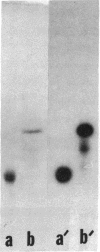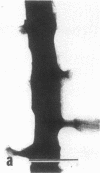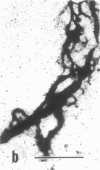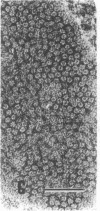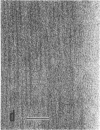Abstract
We describe a class of cationic structural proteins that associate specifically with intermediate filaments (IF) but not with other types of cytoskeletal proteins. These proteins, for which the term filaggrin is introduced, are isolated from the stratum corneum of mammalian epidermis. They are species-distinct proteins; for example, rat and mouse filaggrin have different molecular weights and amino acid compositions, but are nevertheless chemically and functionally ver similar. They interact in vitro with the IF several different types of cells to form large fibers or macrofibrils in which many IF are highly aligned in parallel arrays. Stoichiometric analyses suggest that two molecules of filaggrin bind to each three-chain building block of the IF, possibly by ionic interactions with the coiled-coil alpha-helical regions of the IF.
Full text
PDF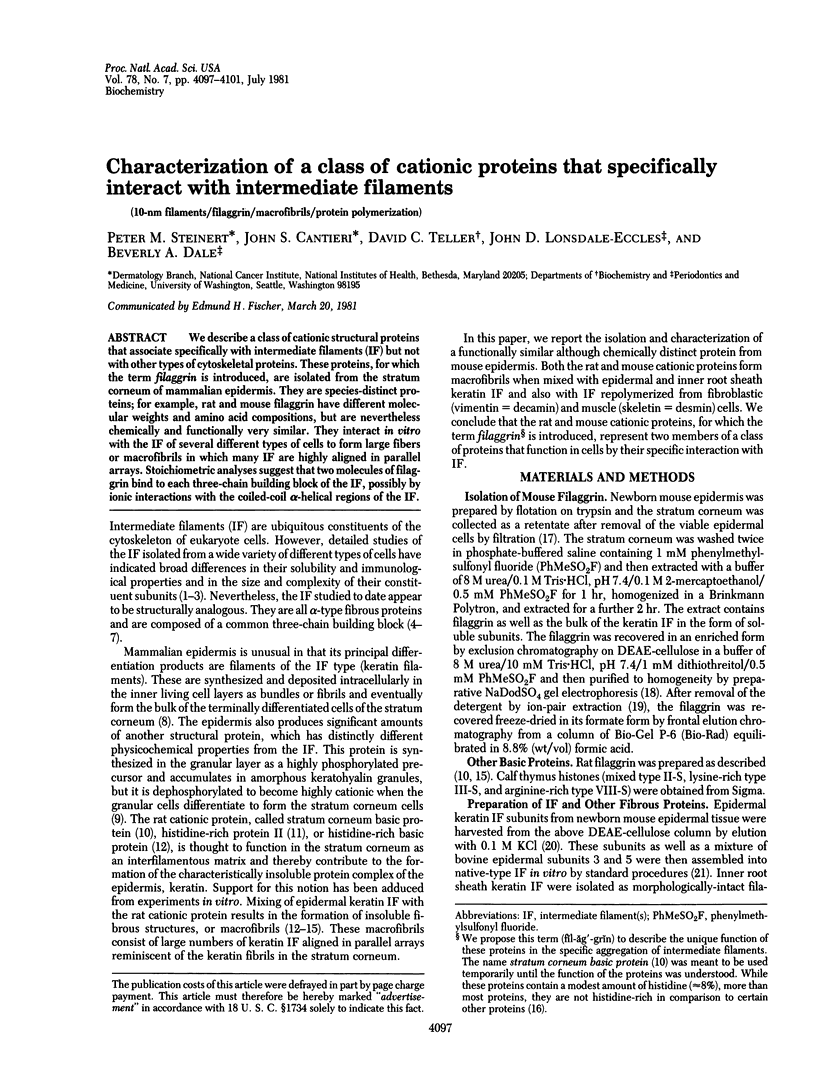
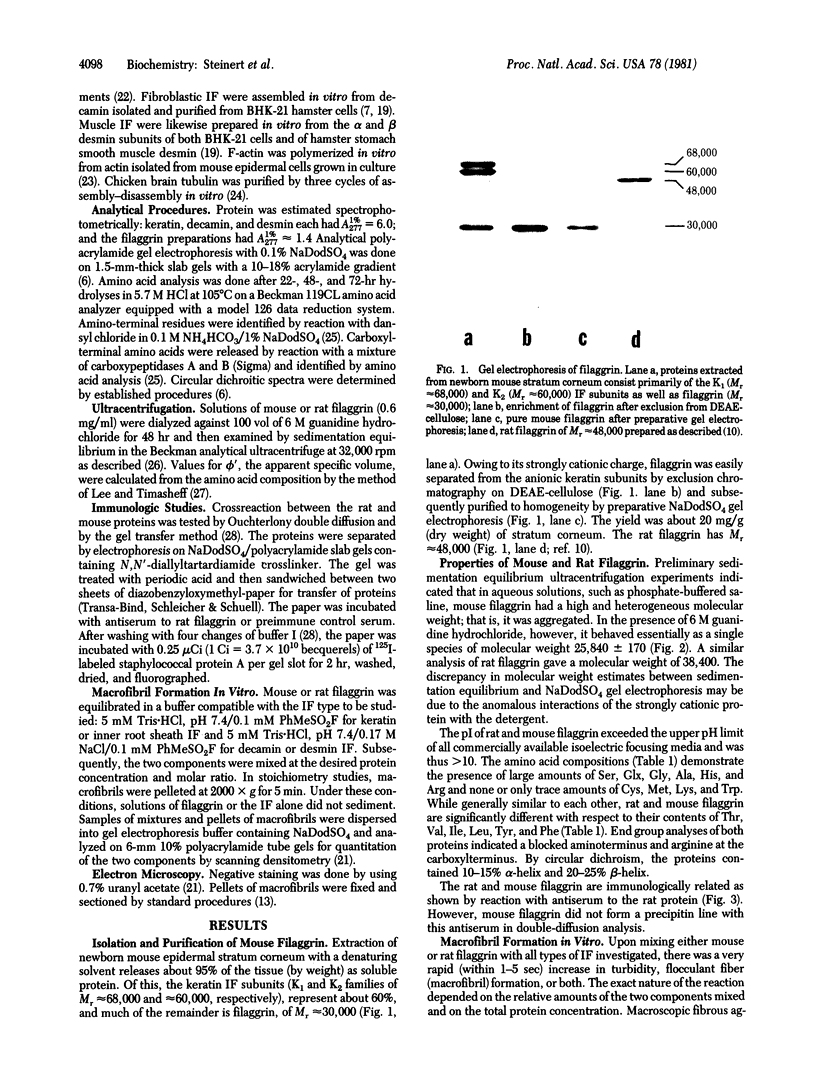
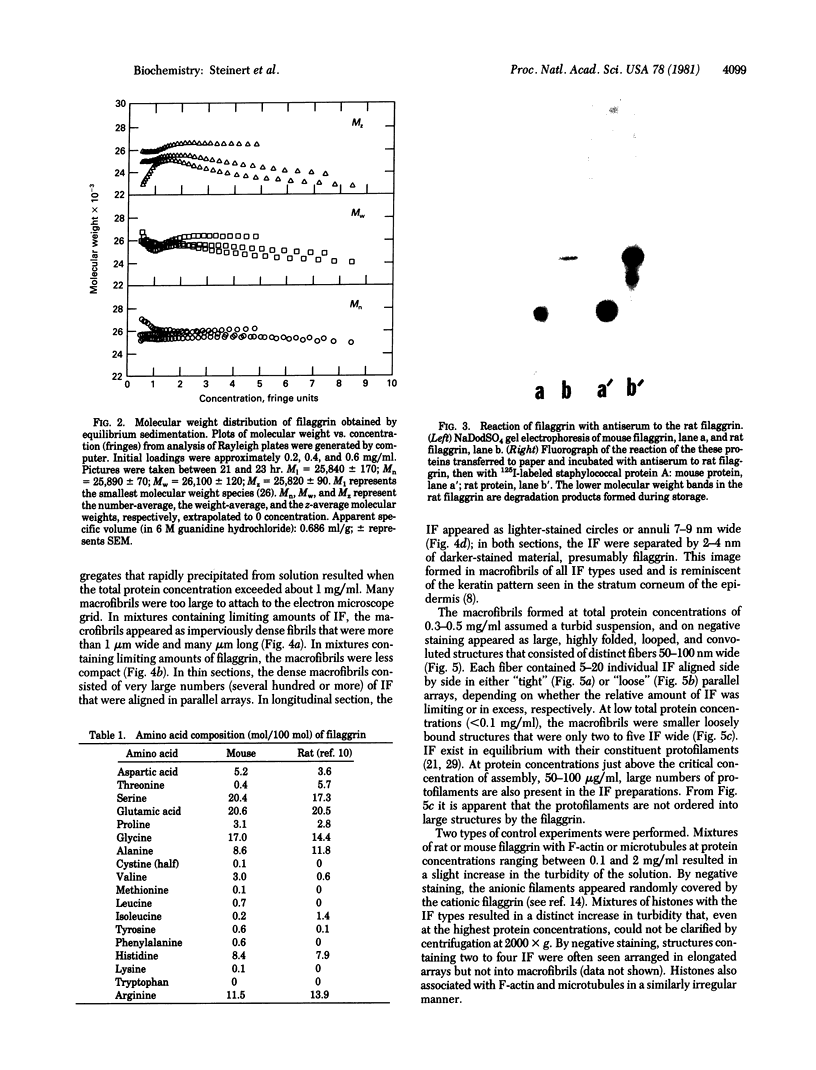
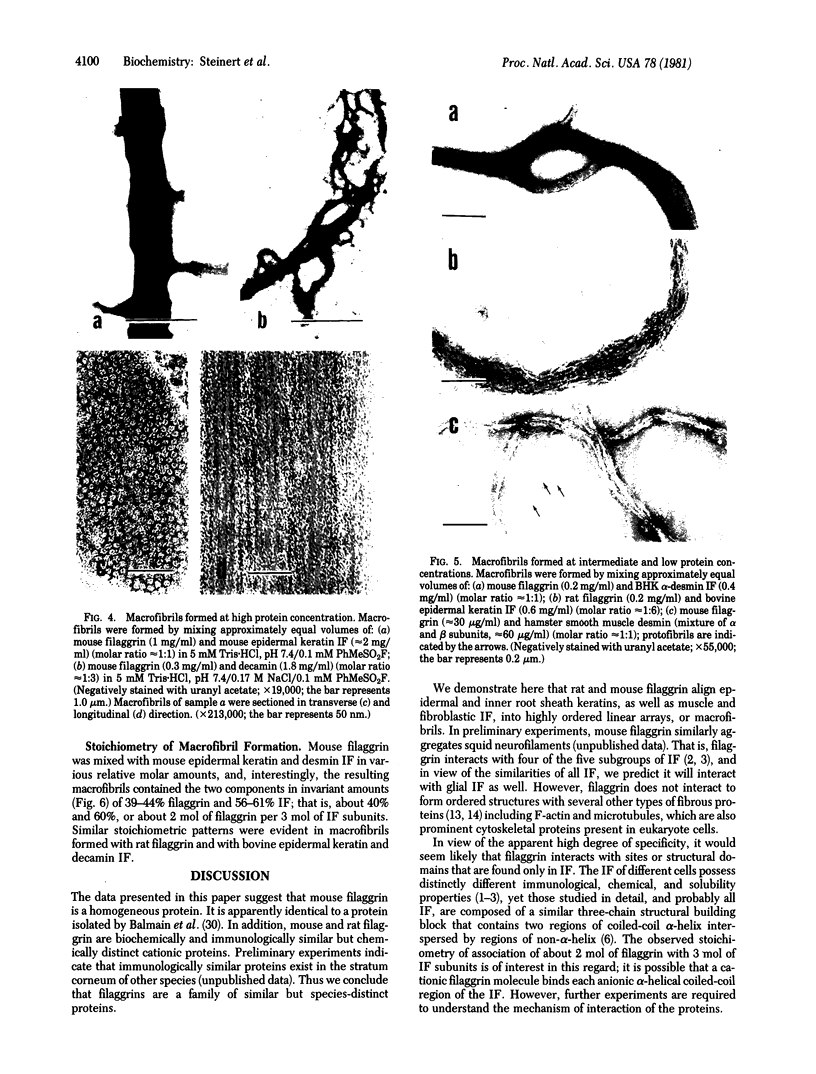
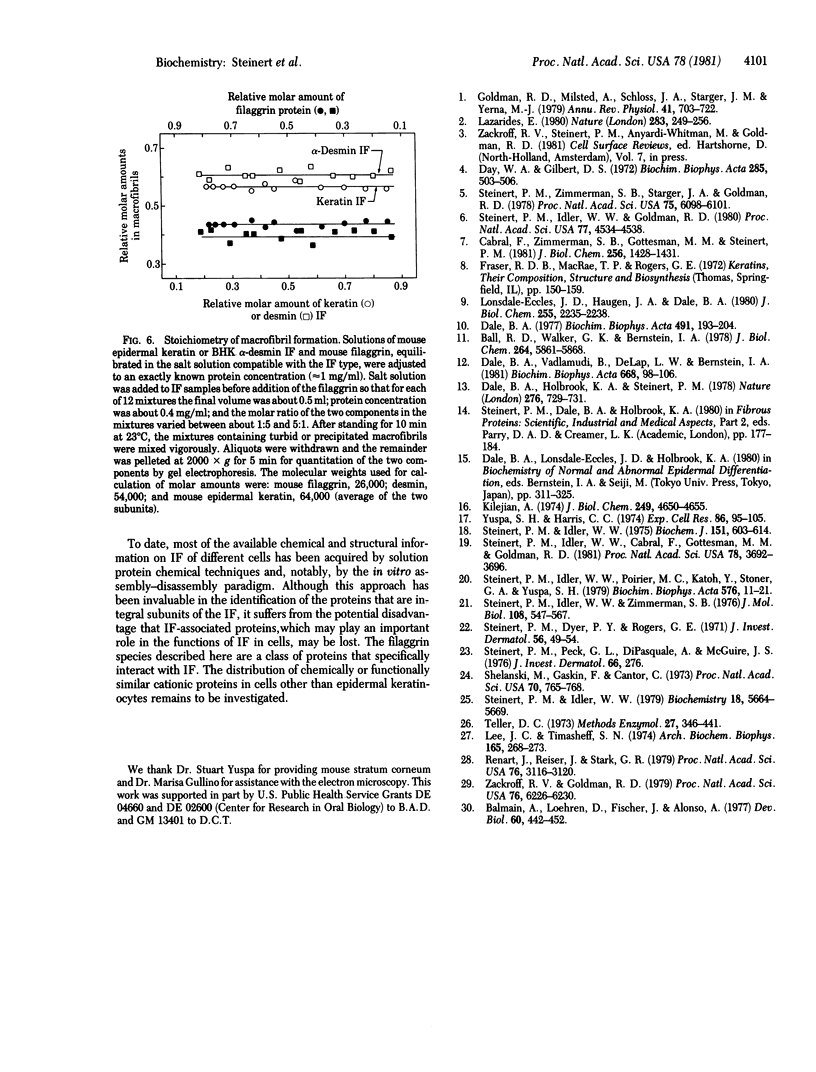
Images in this article
Selected References
These references are in PubMed. This may not be the complete list of references from this article.
- Ball R. D., Walker G. K., Bernstein I. A. Histidine-rich proteins as molecular markers of epidermal differentiation. J Biol Chem. 1978 Aug 25;253(16):5861–5868. [PubMed] [Google Scholar]
- Balmain A., Loehren D., Fischer J., Alonso A. Protein synthesis during fetal development of mouse epidermis. I. The appearance of "histidine-rich protein". Dev Biol. 1977 Oct 15;60(2):442–452. doi: 10.1016/0012-1606(77)90141-5. [DOI] [PubMed] [Google Scholar]
- Cabral F., Gottesman M. M., Zimmerman S. B., Steinert P. M. Intermediate filaments from Chinese hamster ovary cells contain a single protein. Comparison with more complex systems from baby hamster kidney and mouse epidermal cells. J Biol Chem. 1981 Feb 10;256(3):1428–1431. [PubMed] [Google Scholar]
- Dale B. A., Holbrook K. A., Steinert P. M. Assembly of stratum corneum basic protein and keratin filaments in macrofibrils. Nature. 1978 Dec 14;276(5689):729–731. doi: 10.1038/276729a0. [DOI] [PubMed] [Google Scholar]
- Dale B. A. Purification and characterization of a basic protein from the stratum corneum of mammalian epidermis. Biochim Biophys Acta. 1977 Mar 28;491(1):193–204. doi: 10.1016/0005-2795(77)90055-1. [DOI] [PubMed] [Google Scholar]
- Dale B. A., Vadlamudi B., DeLap L. W., Bernstein I. A. Similarities between stratum corneum basic protein and histidine-rich protein II from newborn rat epidermis. Biochim Biophys Acta. 1981 Mar 27;668(1):98–106. doi: 10.1016/0005-2795(81)90153-7. [DOI] [PubMed] [Google Scholar]
- Day W. A., Gilbert D. S. X-ray diffraction pattern of axoplasm. Biochim Biophys Acta. 1972 Dec 28;285(2):503–506. doi: 10.1016/0005-2795(72)90342-x. [DOI] [PubMed] [Google Scholar]
- Goldman R. D., Milsted A., Schloss J. A., Starger J., Yerna M. J. Cytoplasmic fibers in mammalian cells: cytoskeletal and contractile elements. Annu Rev Physiol. 1979;41:703–722. doi: 10.1146/annurev.ph.41.030179.003415. [DOI] [PubMed] [Google Scholar]
- Kilejian A. A unique histidine-rich polypeptide from the malaria parasite, Plasmodium lophurae. J Biol Chem. 1974 Jul 25;249(14):4650–4655. [PubMed] [Google Scholar]
- Lazarides E. Intermediate filaments as mechanical integrators of cellular space. Nature. 1980 Jan 17;283(5744):249–256. doi: 10.1038/283249a0. [DOI] [PubMed] [Google Scholar]
- Lee J. C., Timasheff S. N. The calculation of partial specific volumes of proteins in guanidine hydrochloride. Arch Biochem Biophys. 1974 Nov;165(1):268–273. doi: 10.1016/0003-9861(74)90164-7. [DOI] [PubMed] [Google Scholar]
- Lonsdale-Eccles J. D., Haugen J. A., Dale B. A. A phosphorylated keratohyalin-derived precursor of epidermal stratum corneum basic protein. J Biol Chem. 1980 Mar 25;255(6):2235–2238. [PubMed] [Google Scholar]
- Renart J., Reiser J., Stark G. R. Transfer of proteins from gels to diazobenzyloxymethyl-paper and detection with antisera: a method for studying antibody specificity and antigen structure. Proc Natl Acad Sci U S A. 1979 Jul;76(7):3116–3120. doi: 10.1073/pnas.76.7.3116. [DOI] [PMC free article] [PubMed] [Google Scholar]
- Shelanski M. L., Gaskin F., Cantor C. R. Microtubule assembly in the absence of added nucleotides. Proc Natl Acad Sci U S A. 1973 Mar;70(3):765–768. doi: 10.1073/pnas.70.3.765. [DOI] [PMC free article] [PubMed] [Google Scholar]
- Steinert P. M., Dyer P. Y., Rogers G. E. The isolation of non-keratin protein filaments from inner root sheath cells of the hair follicle. J Invest Dermatol. 1971 Jan;56(1):49–54. doi: 10.1111/1523-1747.ep12291902. [DOI] [PubMed] [Google Scholar]
- Steinert P. M., Idler W. W., Cabral F., Gottesman M. M., Goldman R. D. In vitro assembly of homopolymer and copolymer filaments from intermediate filament subunits of muscle and fibroblastic cells. Proc Natl Acad Sci U S A. 1981 Jun;78(6):3692–3696. doi: 10.1073/pnas.78.6.3692. [DOI] [PMC free article] [PubMed] [Google Scholar]
- Steinert P. M., Idler W. W., Goldman R. D. Intermediate filaments of baby hamster kidney (BHK-21) cells and bovine epidermal keratinocytes have similar ultrastructures and subunit domain structures. Proc Natl Acad Sci U S A. 1980 Aug;77(8):4534–4538. doi: 10.1073/pnas.77.8.4534. [DOI] [PMC free article] [PubMed] [Google Scholar]
- Steinert P. M., Idler W. W., Poirier M. C., Katoh Y., Stoner G. D., Yuspa S. H. Subunit structure of the mouse epidermal keratin filament. Biochim Biophys Acta. 1979 Mar 27;577(1):11–21. doi: 10.1016/0005-2795(79)90003-5. [DOI] [PubMed] [Google Scholar]
- Steinert P. M., Idler W. W. Postsynthetic modifications of mammalian epidermal alpha-keratin. Biochemistry. 1979 Dec 11;18(25):5664–5669. doi: 10.1021/bi00592a022. [DOI] [PubMed] [Google Scholar]
- Steinert P. M., Idler W. W. The polypeptide composition of bovine epidermal alpha-keratin. Biochem J. 1975 Dec;151(3):603–614. doi: 10.1042/bj1510603. [DOI] [PMC free article] [PubMed] [Google Scholar]
- Steinert P. M., Idler W. W., Zimmerman S. B. Self-assembly of bovine epidermal keratin filaments in vitro. J Mol Biol. 1976 Dec 15;108(3):547–567. doi: 10.1016/s0022-2836(76)80136-2. [DOI] [PubMed] [Google Scholar]
- Steinert P. M., Zimmerman S. B., Starger J. M., Goldman R. D. Ten-nanometer filaments of hamster BHK-21 cells and epidermal keratin filaments have similar structures. Proc Natl Acad Sci U S A. 1978 Dec;75(12):6098–6101. doi: 10.1073/pnas.75.12.6098. [DOI] [PMC free article] [PubMed] [Google Scholar]
- Teller D. C. Characterization of proteins by sedimentation equilibrium in the analytical ultracentrifuge. Methods Enzymol. 1973;27:346–441. doi: 10.1016/s0076-6879(73)27017-9. [DOI] [PubMed] [Google Scholar]
- Yuspa S. H., Harris C. C. Altered differentiation of mouse epidermal cells treated with retinyl acetate in vitro. Exp Cell Res. 1974 May;86(1):95–105. doi: 10.1016/0014-4827(74)90653-3. [DOI] [PubMed] [Google Scholar]
- Zackroff R. V., Goldman R. D. In vitro assembly of intermediate filaments from baby hamster kidney (BHK-21) cells. Proc Natl Acad Sci U S A. 1979 Dec;76(12):6226–6230. doi: 10.1073/pnas.76.12.6226. [DOI] [PMC free article] [PubMed] [Google Scholar]




